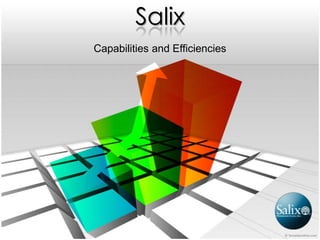Salix
- 2. Agenda â Executive Summary â Link Chart â Capacities â Third Party Manufacturers â Efficiencies â Questions â Contact Information
- 3. Executive Summary â Only as capable as their ability is to attract third party manufactures â Focuses on a niche market â Efficient, but room for improvement
- 5. Capacities
- 6. Capacities Salix has no manufacturing capabilities, due to the fact that all their manufacturing is contracted out to third parties.
- 7. Is this Good or Bad?
- 8. The downside is that they are dependent on third party companies to work with them and manufacture their products The benefit of this practice is that Salix is not constrained by internal manufacturing limitations.
- 9. Salix focuses on a niche market inside The the pharmaceutical industry Gastroenterology Industry
- 10. Pharmaceutical Industry Gastroenterology Industry This allows Salix to compete with larger the research andcompanies that All pharmaceutical development focus on broader markets solely on done at Salix is focused within the pharmaceutical industry gastroenterology
- 11. 150 100 call on 10 sales managers Salix has approximately 280 fullfocus on dedicated to roughly 16,000 who time health care major drug sales employees professionals wholesalers
- 12. Raleigh North Carolina Morrisville North Carolina
- 13. Lease expires in 2015 Headquarters Lease expires in 2011 Morrisville North Carolina Raleigh North Carolina Salix also maintains a small amount of 77,000 SQFT space in Palo Alto, California. 26,000 SQFT
- 15. All of products that Salix Produces
- 16. All of Salixâs third party producers Overall, Salix has 20 Third Party Producers
- 17. ` Efficiencies
- 18. Average Inventory Inventory to Investment Sales Ratio Period Ratio The Analysts used four different ratios to These ratios are as listed as follows; determine Salixâs Efficiency Asset Accounts Turnover Receivable Ratio Ratio
- 19. This ratio can be calculated by The Inventory to Sales Ratio determines Inventory how much inventory is sold inInventory to = a month Sales Ratio Sales for the Month
- 20. Inventory to Sales Ratio 4 3.653731343 3.5 3.375 3.462365591 3 3.036966825 Inventory to Sales Ratio 2.5 2.317241379 2 1.797288573 1.548387097 1.5 1.444604317 1.161073826 1.548387097 1 0.900763359 0.5 0 1999 2000 2001 2002 2003 2004 2005 2006 2007 2008 years Trending Down = EFFICIENT
- 21. This ratio can be calculated by A higher investment AThe Average Inventory Investment Period longer average in inventory means Ratio determines how long itcash available inventory period takes to Average less Investment requires a higher Average Inventory The higher the Current Inventory Balanceother into a dollar efficient outflow cash for Inventory convert a the less of cash the company is flows Period is, investment in = Investment dollar of sales/ accounts receivable from (i.e. paying inventory Daily Cost ofbills, overhead, ext.) Average Period the sale of the inventory Goods Sold (COGS) Ratio
- 22. Average Inventory Investment Period 0.9 0.772727273 0.780701754 0.8 0.8 0.768292683 0.73853211 0.7 Average inventory investment Period 0.6 0.560386473 0.482288828 0.5 0.4 0.456363636 0.3 0.2 0.173913043 0.1 0 2000 2001 2002 2003 2004 2005 2006 2007 2008 Years Trending Up = INEFFICIENT
- 23. This ratio can be calculated by The Asset Turnover Ratio determines how Revenue well a business is using itâs assets to Asset = generate sales Turnover Assets Ratio
- 24. Asset Turnover Ratio 1.4 1.225749559 1.158068057 1.2 1.206755374 1.132309942 1 0.885714286 Asset Turnover Ratio 0.960257787 0.8 0.600536193 0.647331787 0.6 0.570866142 0.5 0.4 0.2 0 1999 2000 2001 2002 2003 2004 2005 2006 2007 2008 Year Trending Up = EFFICIENT
- 25. This ratio can be calculated by The Accounts Receivable Ratio Accounts Receivable Represents the number of sales for which Accounts = collected payments have not yet been Receivable Sales Ratio
- 26. Accounts Receivable Ratio 0.45 0.427586207 0.4 0.35 0.295923261 Acounts Receivable Ratio 0.3 0.25 0.251129761 0.221374046 0.179104478 0.2 0.226510067 0.107142857 0.15 0.099526066 0.1 0.096774194 0.064516129 0.05 0 1999 2000 2001 2002 2003 year 2004 2005 2006 2007 2008 Trending Up = INEFFICIENT
- 27. Questions




























